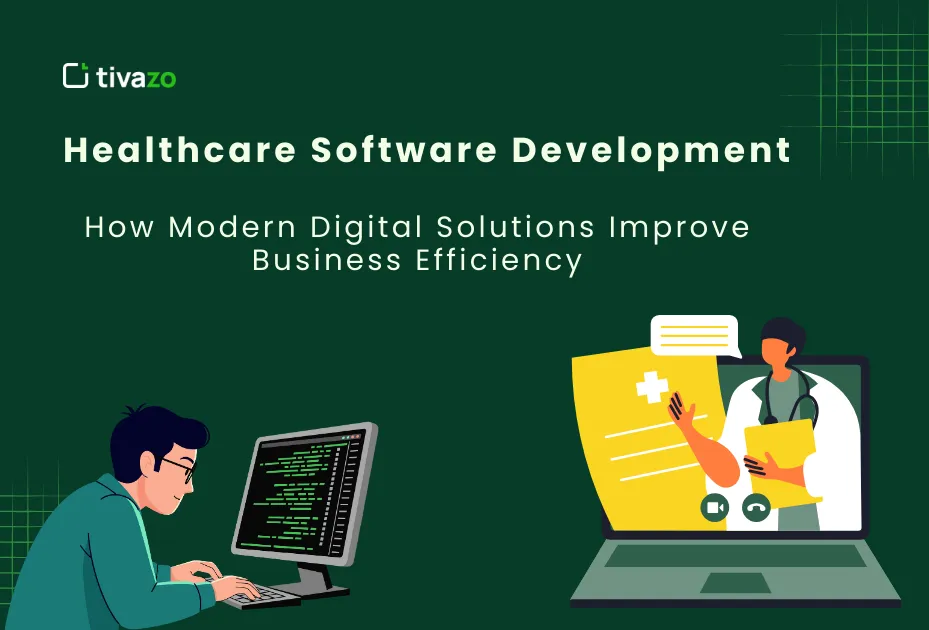Healthcare organizations need to provide excellent patient care while maintaining their budget constraints. The industry now uses digital tools to enhance operational efficiency because patient expectations have increased and regulatory requirements have become more complex. Healthcare software development has become a fundamental requirement because it supports essential functions beyond basic technical needs. Modern healthcare solutions allow professionals to dedicate more time to delivering high-quality patient care.
How Healthcare Software Aligns With Modern Business Productivity Trends
In the same way that traditional businesses in other industries look to place digital transformation, automation, and Artificial Intelligence tools at the center of a changing organizational framework to be more efficient, less manual, and more informed, modern healthcare software is grounded in the same principles of business outlined by Tivazo—enhancing workflow efficiencies, increasing team collaboration, reducing operational spend, and creating scalable digital solutions. With these solutions in place, healthcare providers can operate with the same competitive, technology-based approach taken by the world’s top digital businesses.
The Growing Need for Advanced Digital Healthcare Solutions
Healthcare facilities have undergone a fast digital transformation during the last decade. Telehealth services, mobile healthcare services, and enhanced system connectivity have become more common. The McKinsey Global Telehealth Report shows that virtual care services now serve 38% of patients since the pandemic began, compared to 11% before. This shift has led patients to change their healthcare behaviors quickly.
As healthcare systems expand, the need for dependable digital infrastructure grows. Providers require software systems that unite patient records through automated processes while ensuring compliance with all regulations. Many select contemporary platforms because existing systems cannot support modern medical service delivery methods.
Healthcare facilities must operate at peak efficiency. Administrative work has become a major challenge. Physicians dedicate large portions of their work hours to tasks such as scheduling, documentation, billing, and communication. The Annals of Internal Medicine reports that physicians spend half their work hours on administrative work rather than patient care. This results in staff exhaustion, decreased performance, and increased expenses.

Healthcare software solutions support organizations through:
- Automated workflows
- Secure data management
- Fast data exchange
- Immediate access to patient information
- Improved decision-making
- Better team collaboration
These capabilities enhance operational efficiency across several application areas.
1. Electronic Health Records and Data Management Systems
Electronic Health Records have become the primary digital advancement in healthcare. A properly deployed EHR system unites all patient information into one system and eliminates separate records. Staff can instantly retrieve medical histories, test results, medication lists, and imaging data. This reduces delays, minimizes errors, and supports faster diagnosis and treatment planning.
Advanced EHR systems integrate with laboratory information systems and radiology platforms. This improves accuracy and maintains consistent patient information through a single database.
2. Workflow Automation and Operational Tools
Automation technology handles repetitive tasks, generates appointment reminders, tracks inventory levels, and processes billing. Large organizations that use automation can save more than 200 working hours each month.

The Healthcare Financial Management Association reports that automated billing systems reduce claim errors by 30%, leading to better cash flow management and reduced administrative work. These tools allow staff to focus more on patient care and clinical responsibilities.
3. Telemedicine and Remote Care Platforms
Digital care platforms offer flexible medical services that support both patients and providers. Patients receive care from any location, reduce travel, decrease appointment cancellations, and gain easier access to specialists. Remote monitoring devices allow providers to track chronic conditions and take action before health indicators become abnormal.
Telemedicine platforms also decrease clinic staffing needs and allow resources to be directed toward vital in-person care. They now integrate with EHR systems through automatic data transfer.
4. AI-Powered Diagnostics and Decision Support
AI solutions allow medical staff to process large data sets, identify patterns, and generate alerts for potential health problems. AI tools can identify abnormal lab results and predict upcoming health issues.
The Deloitte Insights report shows that AI-assisted diagnostic systems improve accuracy by 20% in specific specialties. These tools function as extensions that help doctors make faster and more accurate decisions.
5. Patient Engagement and Experience Platforms
Healthcare organizations need to offer digital experiences that match user-friendly applications in other industries. Current patient portals allow scheduling, test result viewing, secure messaging, and access to treatment instructions from one platform.
These tools help patients take an active role in their care, increasing satisfaction and treatment plan compliance. Better understanding leads to improved outcomes and fewer follow-up visits. Organizations that use these tools create efficient operations, financial stability, and regulatory compliance.
Security and Compliance Requirements
Because healthcare organizations handle sensitive information, they must implement software systems that meet security and privacy requirements such as HIPAA and GDPR. Modern solutions include:
- Role-based access controls
- Data encryption during storage and transfer
- Audit trails
- Protected authentication methods
- Automated vulnerability scans
These measures reduce risks and provide stronger protection than outdated manual procedures and legacy infrastructure.
Integration as a Core Element
Healthcare facilities use multiple systems such as scheduling platforms, billing software, EHR systems, pharmacy databases, and imaging systems. Without integration, workflows become fragmented and inefficient.
Integrated systems support continuous data transfer, prevent duplicate records, and create a unified experience for patients. Organizations can use integration to perform analytics that track performance, forecast resource needs, and reveal improvement opportunities. Data can highlight patterns such as appointment cancellations or laboratory workflow delays.
Advantages of Custom Healthcare Software Development
Organizations choose custom healthcare software when standard systems cannot meet their needs. Custom applications offer:
- Tailored workflows
- Medical device integration
- Interface customization
- Compatibility with existing equipment
- Scalable architecture
- Improved user experience
- Reduced manual workloads
Organizations also maintain full control over updates, enhancements, and new features without waiting for vendor releases.
Future Outlook for Healthcare Technology
The healthcare industry will continue evolving as software development advances. AI systems and predictive analytics will become more capable. Interoperability standards will improve, and patient-focused tools will expand. This progress will strengthen coordination, reduce errors, and improve patient outcomes.
Final Thoughts

The modern healthcare system relies on software that improves operational efficiency. These tools reduce administrative work, enhance communication, and support better decision-making. EHR systems, telemedicine platforms, AI diagnostics, and custom applications help shape the future of medical service delivery.
Healthcare organizations that implement these solutions create better conditions for growth and provide high-quality patient care supported by efficient operations, financial stability, and strong regulatory compliance.




